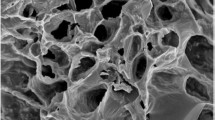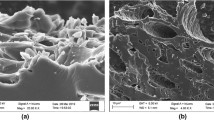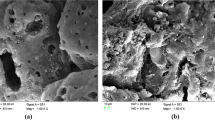Abstract
Removal of phenol from wastewater is essential to achieve permitted concentrations according to the recommendations of USEPA. The adsorption capacity of phenol in activated adsorbent with KOH of Enterolobium contortisiliquum (TAC) was evaluated at different temperatures. The Langmuir isotherm represented the equilibrium data of this study. Thermodynamic process was endothermic, spontaneous, and reversible. The mass transfer parameters ranged from KE 0.68 to 0.96 × 10−3 (cm s−1), Ds 8.95 to 14.35 × 10−9 (cm2 s−1), and Dp 5.023 × 10−8 (cm2 s−1). The PVSDM model represented the adsorption kinetics. Intraparticle diffusion limits the mass transfer process Biot > 100. The two-stage process minimized the total amount of TAC required to achieve the permitted specification of phenol concentration in wastewater from different industrial sectors. TAC showed significant performance in the removal of phenol from wastewater.





Similar content being viewed by others
Data availability
The experimental dataset of this study can be made available upon request and approval of the corresponding author.
Abbreviations
- ARE:
-
Absolute relative deviation (%)
- \({\mathrm{B}}_{1}\) :
-
Temkin model constant (mg g−1)
- Biot:
-
Biot number (dimensionless)
- \({\mathrm{CA}}_{\mathrm{j}}^{\mathrm{exp}}\) :
-
Value obtained experimentally (mg L−1)
- \({\mathrm{CA}}_{\mathrm{j}}^{\mathrm{mod}}\) :
-
Value predicted by the diffusional model (mg L−1)
- \({\mathrm{C}}_{\mathrm{A}}^{\mathrm{o}}\) :
-
Standard concentration of phenol (1.0 mol L−1)
- C(t) :
-
Amount of phenol in the solution at time t (mg L−1)
- CA :
-
Amount of adsorbate in solution at time t (mg L−1)
- CA0 :
-
Initial amount of adsorbate in the fluid phase (mg L−1)
- CAr :
-
Amount of adsorbate inside the particle at position r (mg L−1)
- Ce :
-
Amount of phenol in the solution at equilibrium (mg L−1)
- Co:
-
Initial amount of adsorbate in the fluid phase (mg L−1)
- C1:
-
Amount of adsorbate at equilibrium in stage 1 (mg L−1)
- C2:
-
Amount of adsorbate at equilibrium in stage 2 (mg L−1)
- D AB :
-
Molecular diffusivity of phenol in water (cm2 s−1)
- d p :
-
Pore diameter (nm)
- Dp :
-
Effective pore diffusion coefficient (cm2 s−1)
- Ds :
-
Surface diffusivity (cm2 s−1)
- \({k}_{1}\) :
-
Temkin model constant (L mg−1)
- K E :
-
External convective mass transfer coefficient (cm s−1)
- K F :
-
Freundlich model constant ((mg g−1) (L mg−1)1/m)
- K L :
-
Langmuir constant (L mg−1)
- \({K}_{\mathrm{e}}^{\mathrm{o}}\) :
-
Thermodynamic equilibrium constant (dimensionless)
- K g :
-
Parameter of the best isotherm model (L mg−1)
- m :
-
Freundlich model parameter (dimensionless)
- M A :
-
Phenol molar mass (g mol−1)
- P :
-
Number of experimental points
- q(t) :
-
Amount of phenol adsorbed at time t (mg g−1)
- \({\overline{q} }^{\mathrm{ exp}}\) :
-
Average value obtained experimentally (mg g−1)
- \({q}_{\mathrm{e}}\) :
-
Amount of phenol adsorbed at equilibrium (mg g−1)
- \({q}_{\mathrm{j}}^{\mathrm{exp}}\) :
-
Value obtained experimentally at point j (mg g−1)
- \({q}_{\mathrm{j}}^{\mathrm{mod}}\) :
-
Value predicted by the model at point j (mg g−1)
- q max :
-
Maximum amount of phenol adsorbed Langmuir isotherm (mg g−1)
- R :
-
Universal gas constant (8.314 J mol−1 K−1)
- R 2 :
-
Determination coefficient
- R 2 adj :
-
Adjusted determination coefficient
- S BET Specific area BET (m2 :
-
G−1)
- S EXTExternal surface area (cm2 :
-
G−1)
- t :
-
Time (s)
- T :
-
Temperature (K)
- V :
-
Solution volume (L)
- V pTotal pore volume (cm3 :
-
G−1)
- W :
-
Amount of adsorbent (g)
- W i :
-
Amount of adsorbent in stage i (g)
- W t :
-
Total amount of adsorbent (g)
- Z :
-
Number of parameters for each model to be adjusted
- \(\upgamma\) :
-
Activity coefficient (dimensionless)
- εp :
-
Porosity (dimensionless)
- ρp :
-
Apparent specific mass (g cm−3)
- ρs :
-
Real specific mass (g cm−3)
- ∆H°:
-
Standard enthalpy variation (kJ mol−1)
- ∆G°:
-
Standard Gibbs free energy variation (kJ mol−1)
- ∆S°:
-
Standard entropy variation (kJ mol−1 K−1)
References
Adebayo MA, Areo FI (2021) Removal of phenol and 4-nitrophenol from wastewater using a composite prepared from clay and Cocos nucifera shell: kinetic, equilibrium and thermodynamic studies. Resour Environ Sustain 3:100020. https://doi.org/10.1016/J.RESENV.2021.100020
Alvarenga G, Lima JP, Goszczynski ACF et al (2020) Methylene blue adsorption by timbaúva (Enterolobium contortisiliquum)-derived materials. Environ Sci Pollut Res 27:27893–27903. https://doi.org/10.1007/s11356-020-09113-4
Amran F, Zainuddin NF, Ahmad Zaini MA (2021) Two-stage adsorber design for methylene blue removal by coconut shell activated carbon. Malaysian J Fundam Appl Sci 17:768–775. https://doi.org/10.11113/MJFAS.V17N6.2303
Arampatzidou AC, Deliyanni EA (2016) Comparison of activation media and pyrolysis temperature for activated carbons development by pyrolysis of potato peels for effective adsorption of endocrine disruptor bisphenol-A. J Colloid Interface Sci 466:101–112. https://doi.org/10.1016/J.JCIS.2015.12.003
Ashino R, Nagase M, Vaillancourt R (2000) Behind and beyond the MATLAB ODE suite. Comput Math with Appl 40:491–512. https://doi.org/10.1016/S0898-1221(00)00175-9
Bamatraf SMS, Zaini MAA (2021) Optimization in a two-stage sorption of malachite green by date palm residue carbon. 2021 Int Congr Adv Technol Eng ICOTEN 2021. https://doi.org/10.1109/ICOTEN52080.2021.9493441
Bettin F, Cousseau F, Martins K et al (2019) Phenol removal by laccases and other phenol oxidases of Pleurotus sajor-caju PS-2001 in submerged cultivations and aqueous mixtures. J Environ Manage 236:581–590. https://doi.org/10.1016/J.JENVMAN.2019.02.011
Boehm HP (2002) Surface oxides on carbon and their analysis: a critical assessment. Carbon N Y 40:145–149. https://doi.org/10.1016/S0008-6223(01)00165-8
Cychosz KA, Thommes M (2018) Progress in the physisorption characterization of nanoporous gas storage materials. Engineering 4:559–566. https://doi.org/10.1016/J.ENG.2018.06.001
Dada A, Aziz AH (2017) Treatment of petroleum wastewater by conventional and new technologies—a review. Glob NEST J 19:439–452
Danish M, Ahmad T, Hashim R et al (2018) Comparison of surface properties of wood biomass activated carbons and their application against rhodamine B and methylene blue dye. Surfaces and Interfaces 11:1–13. https://doi.org/10.1016/J.SURFIN.2018.02.001
Tao Y, Wu Y, Han Y et al (2020) Insight into mass transfer during ultrasound-enhanced adsorption/desorption of blueberry anthocyanins on macroporous resins by numerical simulation considering ultrasonic influence on resin properties. Chem Eng J 380:122530. https://doi.org/10.1016/J.CEJ.2019.122530
da Silva RF, Da Ros CO, Antoniolli ZI et al (2018) Growth and tolerance of Enterolobiumcontortisiliquum Vell. seedlings grown in contaminated soil with zinc. Ciência Florest 28:979–986. https://doi.org/10.5902/1980509833374
Díaz-Blancas V, Ocampo-Pérez R, Leyva-Ramos R et al (2018) 3D modeling of the overall adsorption rate of metronidazole on granular activated carbon at low and high concentrations in aqueous solution. Chem Eng J 349:82–91. https://doi.org/10.1016/J.CEJ.2018.05.076
Eder S, Müller K, Azzari P et al (2021) Mass transfer mechanism and equilibrium modelling of hydroxytyrosol adsorption on olive pit–derived activated carbon. Chem Eng J 404:126519. https://doi.org/10.1016/J.CEJ.2020.126519
Fan X, Li S, Sun M et al (2019) Degradation of phenol by coal-based carbon membrane integrating sulfate radicals-based advanced oxidation processes. Ecotoxicol Environ Saf 185:109662. https://doi.org/10.1016/J.ECOENV.2019.109662
Franco DSP, Georgin J, Netto MS et al (2021) Highly effective adsorption of synthetic phenol effluent by a novel activated carbon prepared from fruit wastes of the Ceiba speciosa forest species. J Environ Chem Eng 9:105927. https://doi.org/10.1016/J.JECE.2021.105927
Freundlich H (1907) Über die Adsorption in Lösungen. Zeitschrift Für Phys Chemie 57U:385–470. https://doi.org/10.1515/zpch-1907-5723
Furusawa T, Smith JM (1973) Fluid—particle and intraparticle mass transport rates in slurries. Ind Eng Chem Fundam 12:197–203. https://doi.org/10.1021/i160046a009
Gładysz-Płaska A, Majdan M, Pikus S, Sternik D (2012) Simultaneous adsorption of chromium(VI) and phenol on natural red clay modified by HDTMA. Chem Eng J 179:140–150. https://doi.org/10.1016/J.CEJ.2011.10.071
Gokce Y, Aktas Z (2014) Nitric acid modification of activated carbon produced from waste tea and adsorption of methylene blue and phenol. Appl Surf Sci 313:352–359. https://doi.org/10.1016/J.APSUSC.2014.05.214
Hijab M, Parthasarathy P, Mackey HR et al (2021) Minimizing adsorbent requirements using multi-stage batch adsorption for malachite green removal using microwave date-stone activated carbons. Chem Eng Process - Process Intensif 167:108318. https://doi.org/10.1016/J.CEP.2021.108318
Huang J, Jin X, Deng S (2012) Phenol adsorption on an N-methylacetamide-modified hypercrosslinked resin from aqueous solutions. Chem Eng J 192:192–200. https://doi.org/10.1016/J.CEJ.2012.03.078
Iheanacho OC, Nwabanne JT, Obi CC, Onu CE (2021) Packed bed column adsorption of phenol onto corn cob activated carbon: linear and nonlinear kinetics modeling. South African J Chem Eng 36:80–93. https://doi.org/10.1016/J.SAJCE.2021.02.003
Ipek I, Kabay N, Yüksel M (2017) Separation of bisphenol A and phenol from water by polymer adsorbents: equilibrium and kinetics studies. J Water Process Eng 16:206–211. https://doi.org/10.1016/J.JWPE.2017.01.006
Jaria G, Calisto V, Esteves VI, Otero M (2022) Overview of relevant economic and environmental aspects of waste-based activated carbons aimed at adsorptive water treatments. J Clean Prod 344:130984. https://doi.org/10.1016/J.JCLEPRO.2022.130984
Jung KW, Choi BH, Hwang MJ et al (2017) Adsorptive removal of anionic azo dye from aqueous solution using activated carbon derived from extracted coffee residues. J Clean Prod 166:360–368. https://doi.org/10.1016/J.JCLEPRO.2017.08.045
Kaveeshwar AR, Kumar PS, Revellame ED et al (2018) Adsorption properties and mechanism of barium (II) and strontium (II) removal from fracking wastewater using pecan shell based activated carbon. J Clean Prod 193:1–13. https://doi.org/10.1016/J.JCLEPRO.2018.05.041
Kong X, Gao H, Song X et al (2020) Adsorption of phenol on porous carbon from Toona sinensis leaves and its mechanism. Chem Phys Lett 739:137046. https://doi.org/10.1016/J.CPLETT.2019.137046
Krishna Prasad R, Srivastava SN (2009) Sorption of distillery spent wash onto fly ash: kinetics and mass transfer studies. Chem Eng J 146:90–97. https://doi.org/10.1016/J.CEJ.2008.05.021
Kuleyin A (2007) Removal of phenol and 4-chlorophenol by surfactant-modified natural zeolite. J Hazard Mater 144:307–315. https://doi.org/10.1016/J.JHAZMAT.2006.10.036
Laksaci H, Khelifi A, Trari M, Addoun A (2017) Synthesis and characterization of microporous activated carbon from coffee grounds using potassium hydroxides. J Clean Prod 147:254–262. https://doi.org/10.1016/J.JCLEPRO.2017.01.102
Lam SS, Liew RK, Wong YM et al (2017) Microwave-assisted pyrolysis with chemical activation, an innovative method to convert orange peel into activated carbon with improved properties as dye adsorbent. J Clean Prod 162:1376–1387. https://doi.org/10.1016/J.JCLEPRO.2017.06.131
Langmuir I (1916) The constitution and fundamental properties of solids and liquids. Part I. Solids J Am Chem Soc 38:2221–2295. https://doi.org/10.1021/ja02268a002
Lee CG, Hong SH, Hong SG et al (2019) Production of biochar from food waste and its application for phenol removal from aqueous solution. Water Air Soil Pollut 230:1–13. https://doi.org/10.1007/S11270-019-4125-X/TABLES/4
Leyva-Ramos R, Geankoplis CJ (1985) Model simulation and analysis of surface diffusion of liquids in porous solids. Chem Eng Sci 40:799–807. https://doi.org/10.1016/0009-2509(85)85032-6
Leyva-Ramos R, Geankoplis CJ (1994) Diffusion in liquid-filled pores of activated carbon. I. Pore volume diffusion. Can J Chem Eng 72:262–271. https://doi.org/10.1002/CJCE.5450720213
Liao Y, Tian M, Goh S et al (2018) Effects of internal concentration polarization and membrane roughness on phenol removal in extractive membrane bioreactor. J Memb Sci 563:309–319. https://doi.org/10.1016/J.MEMSCI.2018.05.074
Lima EC, Hosseini-Bandegharaei A, Moreno-Piraján JC, Anastopoulos I (2019) A critical review of the estimation of the thermodynamic parameters on adsorption equilibria. Wrong use of equilibrium constant in the Van’t Hoof equation for calculation of thermodynamic parameters of adsorption. J Mol Liq 273:425–434. https://doi.org/10.1016/J.MOLLIQ.2018.10.048
Lima JP, Alvarenga G, Goszczynski ACF et al (2020) Batch adsorption of methylene blue dye using Enterolobium contortisiliquum as bioadsorbent: experimental, mathematical modeling and simulation. J Ind Eng Chem 91:362–371. https://doi.org/10.1016/j.jiec.2020.08.029
Lima JP, Costa AE, Rosso SR et al (2022) Scale-up and mass transfer of the adsorption/desorption process of anthocyanins in amorphous silica. J Food Eng 317:110883. https://doi.org/10.1016/J.JFOODENG.2021.110883
Lorenc-Grabowska E (2016) Effect of micropore size distribution on phenol adsorption on steam activated carbons. Adsorption 22:599–607. https://doi.org/10.1007/S10450-015-9737-X/FIGURES/6
Lupa L, Cocheci L, Pode R, Hulka I (2018) Phenol adsorption using Aliquat 336 functionalized Zn-Al layered double hydroxide. Sep Purif Technol 196:82–95. https://doi.org/10.1016/J.SEPPUR.2017.10.003
Mandal A, Das SK (2019) Phenol adsorption from wastewater using clarified sludge from basic oxygen furnace. J Environ Chem Eng 7:103259. https://doi.org/10.1016/J.JECE.2019.103259
Meneghello GE, Mattei VL (2004) Direct sowing of “timbauva” (Enterolobiumcontortisiliquum), “canafistula” (Peltophorumdubium) and “cedro” (Cedrelafissilis) in agricultural unproductive areas. Ciência Florest 14:21–27. https://doi.org/10.5902/198050981803
Morales-Mendoza G, Alvarez-Lemus M, López R et al (2016) Combination of Mn oxidation states improves the photocatalytic degradation of phenol with ZnAl LDH materials without a source of O2 in the reaction system. Catal Today 266:62–71. https://doi.org/10.1016/J.CATTOD.2015.11.028
Moreno-Pérez J, Pauletto PS, Cunha AM et al (2021) Three-dimensional mass transport modeling of pharmaceuticals adsorption inside ZnAl/biochar composite. Colloids Surfaces A Physicochem Eng Asp 614:126170. https://doi.org/10.1016/J.COLSURFA.2021.126170
Naguib DM, Badawy NM (2020) Phenol removal from wastewater using waste products. J Environ Chem Eng 8:103592. https://doi.org/10.1016/J.JECE.2019.103592
Ocampo-Perez R, Leyva-Ramos R, Mendoza-Barron J, Guerrero-Coronado RM (2011) Adsorption rate of phenol from aqueous solution onto organobentonite: surface diffusion and kinetic models. J Colloid Interface Sci 364:195–204. https://doi.org/10.1016/J.JCIS.2011.08.032
Oladipo AA, Ifebajo AO (2018) Highly efficient magnetic chicken bone biochar for removal of tetracycline and fluorescent dye from wastewater: two-stage adsorber analysis. J Environ Manage 209:9–16. https://doi.org/10.1016/J.JENVMAN.2017.12.030
Özacar M, Şengil IA (2006) A two stage batch adsorber design for methylene blue removal to minimize contact time. J Environ Manage 80:372–379. https://doi.org/10.1016/J.JENVMAN.2005.10.004
Polat H, Molva M, Polat M (2006) Capacity and mechanism of phenol adsorption on lignite. Int J Miner Process 79:264–273. https://doi.org/10.1016/J.MINPRO.2006.03.003
Prince K, Smith M (2004) Purification process scale-up. In: Methods in molecular biology (Clifton, N.J.). Humana Press, pp 463–480
Raza W, Lee J, Raza N et al (2019) Removal of phenolic compounds from industrial waste water based on membrane-based technologies. J Ind Eng Chem 71:1–18. https://doi.org/10.1016/J.JIEC.2018.11.024
Rodrigues AE, Silva CM (2016) What’s wrong with Lagergreen pseudo first order model for adsorption kinetics? Chem Eng J 306:1138–1142. https://doi.org/10.1016/j.cej.2016.08.055
Sable SS, Shah KJ, Chiang PC, Lo SL (2018) Catalytic oxidative degradation of phenol using iron oxide promoted sulfonated-ZrO2 by advanced oxidation processes (AOPs). J Taiwan Inst Chem Eng 91:434–440. https://doi.org/10.1016/J.JTICE.2018.06.030
Schiesser WE, Griffiths GW (2009) An introduction to the method of lines. In: A compendium of partial differential equation models. Cambridge University Press, pp 1–17
Shi S, Liu J, Xu J et al (2019) Effects of biochar on the phenol treatment performance and microbial communities shift in sequencing batch reactors. Water Res 161:1–10. https://doi.org/10.1016/J.WATRES.2019.05.097
Temkin MJ, Pyzhev V (1940) Recent modifications to Langmuir isotherms. Acta Physico-Chimica Sinica 12:217–222
Lv S, Li C, Mi J, Meng H (2020) A functional activated carbon for efficient adsorption of phenol derived from pyrolysis of rice husk, KOH-activation and EDTA-4Na-modification. Appl Surf Sci 510:145425. https://doi.org/10.1016/J.APSUSC.2020.145425
Thommes M, Kaneko K, Neimark AV et al (2015) Physisorption of gases, with special reference to the evaluation of surface area and pore size distribution (IUPAC Technical Report). Pure Appl Chem 87:1051–1069. https://doi.org/10.1515/PAC-2014-1117/PDF
Tran HN, Wang YF, You SJ, Chao HP (2017) Insights into the mechanism of cationic dye adsorption on activated charcoal: the importance of π–π interactions. Process Saf Environ Prot 107:168–180. https://doi.org/10.1016/J.PSEP.2017.02.010
Vasudevan S (2014) An efficient removal of phenol from water by peroxi-electrocoagulation processes. J Water Process Eng 2:53–57. https://doi.org/10.1016/J.JWPE.2014.05.002
Vázquez I, Rodríguez-Iglesias J, Marañón E et al (2007) Removal of residual phenols from coke wastewater by adsorption. J Hazard Mater 147:395–400. https://doi.org/10.1016/J.JHAZMAT.2007.01.019
Víctor-Ortega MD, Ochando-Pulido JM, Martínez-Ferez A (2016a) Performance and modeling of continuous ion exchange processes for phenols recovery from olive mill wastewater. Process Saf Environ Prot 100:242–251. https://doi.org/10.1016/J.PSEP.2016.01.017
Víctor-Ortega MD, Ochando-Pulido JM, Martínez-Férez A (2016b) Phenols removal from industrial effluents through novel polymeric resins: kinetics and equilibrium studies. Sep Purif Technol 160:136–144. https://doi.org/10.1016/J.SEPPUR.2016.01.023
Acknowledgements
The authors of this paper thank the Coordination for Improvement of Higher Education (CAPES) for the granting of the scholarship of the second author.
Author information
Authors and Affiliations
Contributions
JPL: conceptualization, methodology, visualization, formal analysis, validation, investigation, writing—review and editing. GA: conceptualization, methodology, writing—review and editing. GRR: conceptualization, writing—review and editing, project administration, supervision. TJL: conceptualization, writing—review and editing, project administration, supervision.
Corresponding author
Additional information
Responsible Editor: Tito Roberto Cadaval Jr
Publisher's note
Springer Nature remains neutral with regard to jurisdictional claims in published maps and institutional affiliations.
Supplementary Information
Below is the link to the electronic supplementary material.
Rights and permissions
About this article
Cite this article
Lima, J.P., Alvarenga, G., Rosa, G.R. et al. Alternative activated/KOH adsorbent for phenol adsorption: experimental, industrial case study and mass transfer interpretation. Environ Sci Pollut Res 29, 77698–77710 (2022). https://doi.org/10.1007/s11356-022-21313-8
Received:
Accepted:
Published:
Issue Date:
DOI: https://doi.org/10.1007/s11356-022-21313-8




